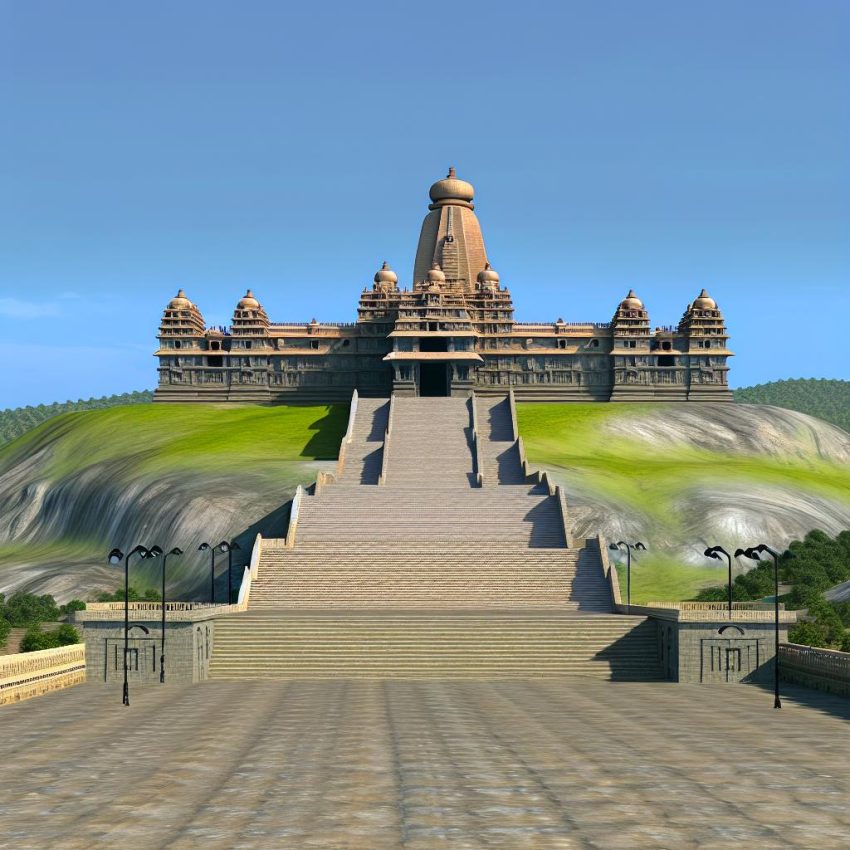Shravanabelagola Jain Temple
Shravanabelagola stands as a prominent pilgrimage destination for adherents of Jainism. Located in the Hassan district of Karnataka, India, this ancient town is revered for its grand monolithic statue of Gommateshwara Bahubali. The town continues to attract visitors from all over the world, drawn by its tranquility and the deep historical roots that render it a crucial site for both cultural and spiritual exploration.
Historical Significance
The name Shravanabelagola carries meaningful connotations in its native Kannada language, referring to the presence of a pond, as the term ‘belagola’ translates to ‘white pond’. This town holds a profound connection to Jain history and spirituality, which is reflected in its ancient texts that document a heritage spanning thousands of years.
The centerpiece of Shravanabelagola’s historical allure is the statue of Bahubali, also known as Gommateshwara. This colossal statue was erected in 983 AD courtesy of the Ganga dynasty’s minister and commander, Chavundaraya. Crafted from a single piece of granite, the statue reaches an astounding height of approximately 57 feet, making it one of the most remarkable free-standing monolithic statues worldwide.
The establishment of the statue was not only a masterpiece of art but a demonstration of the era’s religious devotion and architectural prowess. It encapsulates the life and teachings of Bahubali, a Jain figure celebrated for his spiritual awakening and renunciation.
Architectural Marvel
The statue of Gommateshwara at Shravanabelagola is an outstanding representation of ancient Indian sculptural art. It portrays Bahubali in a unique standing meditation pose, emulating peace and renunciation, key tenets of Jain philosophy. The intricate detailing, from the expressions carved on the statue’s face to the foliage and creepers intricately sculpted on his body, showcases the remarkable artistry and dedication of the craftsmen from that period.
Beyond its size, the statue’s notable features include its lifelike representation and symbolic posture, which are achieved through sophisticated techniques that suggest a deep understanding of geometry and human anatomy. The artisans effectively captured an essence of divinity and tranquility that resonates with visitors and pilgrims alike.
Chandragiri and Vindhyagiri Hills
The temple complex in Shravanabelagola is spread across two significant hills: Chandragiri and Vindhyagiri. Each hill offers immense spiritual and historical value to the Jain community, representing different facets of their religious history and tradition.
Chandragiri: This hill is known for housing numerous Jain temples and the memorable site associated with a revered Jain teacher, Bhadrabahu, and his disciple Chandragupta Maurya. Chandragupta Maurya, a monumental figure in Indian history and founder of the Maurya Empire, is said to have embraced Jainism. He renunciated his kingdom to spend his last years in asceticism at Shravanabelagola.
This act of renunciation by such a powerful ruler underlines the hill’s spiritual significance and its role in hosting a lineage of learned monks and spiritual teachers. The structures and monuments on Chandragiri stand as a testament to the impact of Jain teachings on individuals and societies throughout history.
Vindhyagiri: Also known as Indragiri, this hill is the site of the grand statue of Gommateshwara. Vindhyagiri plays a focal role in Jain celebrations, particularly during the Mahamastakabhisheka, a grand festival that occurs once every 12 years. The festival transforms the hill into a vibrant center of pilgrimage, where rituals and ceremonies enhance the spiritual ambiance for all participants and visitors.
Mahamastakabhisheka Festival
The Mahamastakabhisheka is a celebrated Jain festival conducted in Shravanabelagola. During this grand event, the statue of Gommateshwara is meticulously anointed with a myriad of sacred substances such as milk, curd, saffron, and even gold coins. These ceremonial ablutions symbolize purity and the shedding of earthly ties, resonating with the principles of Jainism.
The festival attracts an impressive influx of Jain pilgrims and tourists, united in observing this elaborate ritual that draws attention to the enduring spiritual heritage of the site. The Mahamastakabhisheka, through its elaborate ceremonies and reverent activities, fosters a vibrant yet deeply spiritual atmosphere that leaves a lasting impact on all who take part or witness the proceedings.
The grandeur of Shravanabelagola, from its unparalleled sculpture to its rich historical lineage, offers a multifaceted look into Jain traditions and art. The town continues to be a beacon for those exploring spiritual enrichment and cultural discovery. Its hills, temples, and ceremonies provide an engaging insight into a profound historical legacy.
For those interested in exploring Shravanabelagola, a range of travel resources provides additional insight into planning visits, including guidance on transportation, local accommodations, and cultural etiquettes. Visitors can gain further insights by exploring websites dedicated to Indian cultural heritage and religious tourism, where comprehensive information can be accessed for a fulfilling visit.
